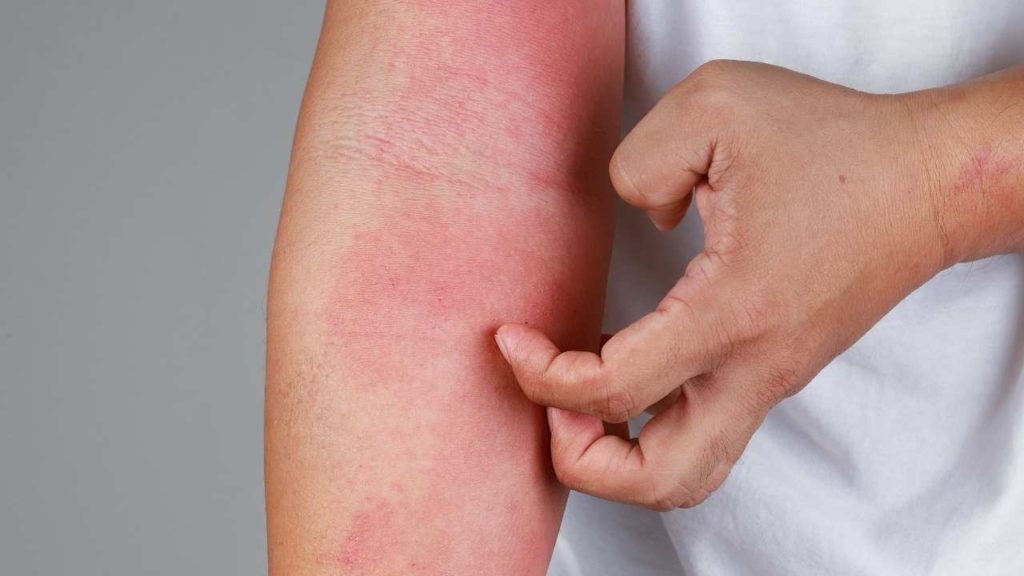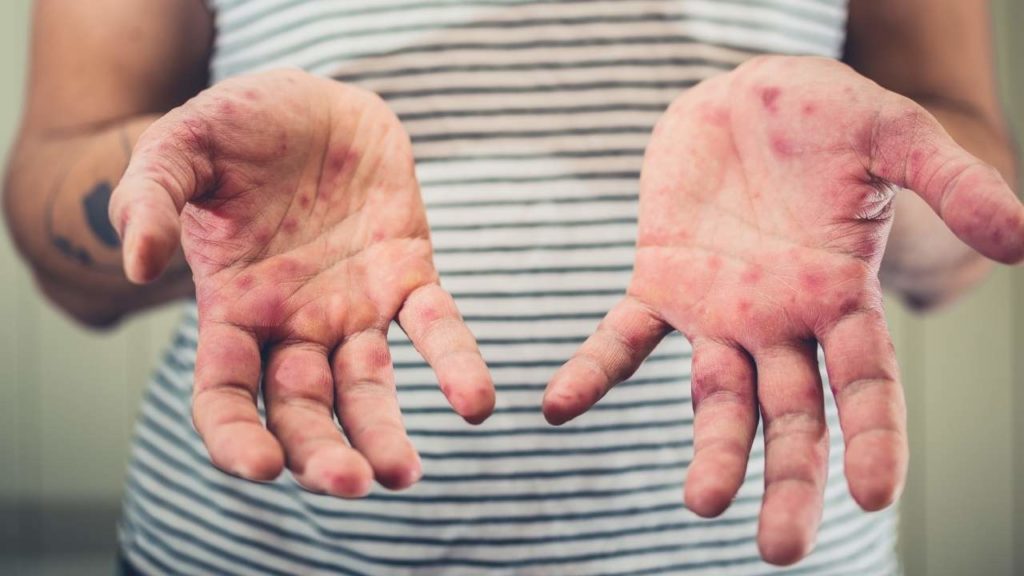Shea Butter for Eczema
Shea butter, in my opinion, is simply underestimated. Even though many people know about it they still delegate it as an ingredient for balms and cracked skin. But Shea butter is incredibly powerful because of the nutrients it possesses. Let me show you in this article how it can help relieve you from eczema symptoms.
Disclaimer: Don’t try any new at-home remedy without consulting your doctor.
In a recent study, Shea butter was shown to be effective in treating eczema. Eczema is a skin condition that causes itching, dryness, redness, and inflammation. It can make skin cracked and itchy. In the pin below I show how Shea butter helps relieve the eczema in between my eyebrows:
In this article, I explain how Shea butter is an effective treatment for eczema. I will provide you with some important information on what this butter is and how it can help eczema sufferers. I will also give you some helpful tips on using it to help your skin stay healthy.
- Approximately 31.6 million people in the United States have some form of eczema and 91% of atopic dermatitis patients experience itching on a daily basis (source)
- The best way to prevent an eczema flare is to keep your skin well moisturized. Recent research suggests that moisturizing a baby’s skin from birth may help prevent eczema from developing (source)
- Shea butter is an EXCELLENT moisturizer for eczema and other dry skin conditions. It contains fat, vitamins and minerals that will properly nourish and moisturize your skin.

Close to Home
When I saw my sister’s skin around 2 years ago I literally froze in horror. Her skin was so itchy and red and it looked like a burn with white ash on it. I couldn’t even look at it without feeling sorry for her!
She was suffering from eczema which is actually a skin condition that affects 10% of the population in the US. According to some statistics, this number is over 30 million people in the US.
What is Eczema?
Eczema, like atopic dermatitis, is a skin condition that can cause inflammation and irritation – it can be a serious skin condition due to the severity of symptoms in some cases, and the parts of the body that it may affect.
One of the symptoms of eczema includes dry skin. The skin may then crack open and be susceptible to bacterial infections. The scaly, flaky skin may be itchy and prickly to the touch. Eczema can also cause the skin to be red, swollen, and cracked. That’s how bad my sister’s skin was at the time.
Here’s what the symptoms of eczema can include:
· Itchy skin
· Flaky skin
· Dry skin, sensitive skin
· Red, slightly raised patches of skin
· Skin that is thickened or scaly
· Skin that is crusty
· Swollen areas
About How It Affects Eczema Sufferers
Eczema sufferers can have unending itching, burning or soreness on the skin, which can prevent them from normal daily activities and even cause severe distress. I have many people approach me at the market where I sell my workshops and natural cosmetics asking for some cream for their itchy skin. Shea butter has worked EVERY TIME I’ve recommended it.

Generally, scratching or rubbing the itchy rash would usually make it worse. Over time, this can cause the skin damage permanence. I suspect the sufferer can even become socially withdrawn and anxious over the condition.
For teenagers, particularly, it can be embarrassing to have these red, scaly patches of skin in places like the arms and legs (scratching can lead to scarring as well).
I could be possible that conditions like eczema on kids may be a reason for poor performance at school as a result of not being able to focus and concentrate.
Check some interesting eczema facts here: https://nationaleczema.org/research/eczema-facts/
https://www.medicinenet.com/atopic_dermatitis_vs_eczema/article.htm
What Causes Eczema?
The cause of eczema isn’t entirely known; researchers believe that there may be a combination of genetic and environmental factors involved.
The following loop takes: an immune system that is sensitive to allergens and irritants will react when exposed to the allergens. The immune cells release chemicals which in turn inflame the skin. This will cause the skin to itch. As a result, we scratch. Scratching then breaks the surface of the skin (due to a defective skin barrier) which then allows moisture to escape, and, bacteria to come in.
The following can trigger eczema:
- Food allergies (particularly in children)
- Pet allergies
- Being in contact with something in particular on a regular basis
- Dry skin
- Hormones (hormone fluctuation in women)
- Hot weather (sweat causes irritation) / Cold weather (skin tends to dry)
- Skin irritants
- Dust mites
- Stress
- Allergies
- Cigarette smoke (including passive smoking the smoke irritates the skin)
- Bacterial and viral infections (cold, herpes, etc)
You can have an eczema diagnose via the right tests.
Is There a Cure?
There is no known cure for eczema. It could be argued that eczema is “an itch that won’t heal.” But, as many of eczema suffers know, it CAN be treated.
Even though is no one best treatment for eczema there are many ways to help relieve its symptoms. The idea, in my view, is to use natural products to help relieve them. That way we’re not exposing the skin to harsher commercial chemicals that can eventually cause more damage than good to our skin, our bodies and our planet.
The Soak & Seal Method:
1. SOAK IN THE BATH OR REGULAR SHOWERS FOR 10-15 MINS: Water should be lukewarm, not hot. The skin is not retaining moisture. By soaking in the bath the skin will be getting the moisture it needs. At least 1 bath or 1 shower a day. Try to avoid scrubbing the skin. I actually never use a sponge, I only use my hands for washing.

2. APPLY A MOISTURIZER: Within 3 minutes of showering of bathing, apply a moisturizer that’s high in fat content to lock in that moisture as well as protect your skin barrier. Here’s where Shea butter shines as a FANTASTIC moisture locking product, full of fatty acids that have incredible added benefits for your skin.

3. APPLY MOISTURIZER TWICE A DAY: Try to apply your moisturizer twice a day (after your bath or shower and then again in the evening).
Remember to always use hypoallergenic, fragrance free, low pH products in general to keep the condition as manageable as possible. My sister NEVER buys anything with added fragrances or any non-natural ingredient. This has made a HUGE difference!
Read this article for more information on Soaking & Sealing.
Below are my top 2 favorite totally natural eczema treatments:
· Shea Butter for Eczema – Organic is the way to go, this is one of the best natural products to use if you suffer from eczema or atopic dermatitis.
· Aloe Vera Gel for Eczema – Aloe Vera is a great natural healing and soothing agent for eczema. If you’re suffering from eczema or atopic dermatitis, you should try out aloe vera.
In this post I’m writing only about Shea butter for eczema since each of the above natural products deserve their own separate entry.
Shea is a wonderful natural remedy for treating this skin condition AND I CAN’T RECOMMEND IT ENOUGH!! Not only my customer’s have found relief using the butter, but it is highly beneficial for the skin in general, and I’ve included a couple of easy recipes below to help you use it effectively.
Shea Butter for Eczema
Let’s have a very quick look first at this butter. What is it exactly? The butter is derived from the karite tree, which grows in West Africa, along the rivers of Ghana. The entire process is a secret well guarded by the African women who make it, and it takes some effort to go from tree to butter. These women work hard to gather the kernels and turn them into a product that is then packed in containers and shipped across the world. Kudos to the women who make a living from this.

The primary ingredient in organic shea butter is not oil but is the fatty substance called triterpene glycerides, which is solid at room temperature and melts slowly at body temperature.
Its fatty acids composition include:
- 45% oleic acids,
- 6% linoleic acid,
- 40% stearic acid and
- 4% palmitic acid
- In addition, it contains such beneficial components as allantoin, polyphenols and Vitamins A and C. According to research it is also high in antioxidants and vitamin D that have been shown useful for skin.
There are no known negative side effects to using Shea butter on skin.
Shea Butter as an Eczema Treatment
Not all butters are the same. Unrefined, raw Shea butter is the best choice for eczema since it contains the highest amount of antioxidants, vitamins and other beneficial components to help nourish and heal the skin. Refined Shea butter has gone through a process that can strip up to 95% of its vitamins.
Below I’ll show you how to make your own heal your eczema naturally by using this product. Ideally, you would use 100% organic unrefined and raw shea butter. This product is not a cure but it can help you manage the situation and alleviate the symptoms of your skin condition.
Collagen Production
The most important thing when dealing with eczema is to increase the level of collagen within our bodies. When we’re young, our body produces enough collagen to repair itself quickly after injury. As we age however, our body starts producing less collagen causing wrinkles and sagging skin. In order to reverse these aging processes, we need to supplement our diet with foods rich in Vitamin B3 and Vitamin E. Both of these nutrients stimulate collagen production.
Let’s have a look at some benefits this butter offers when it comes to collagen production:
- It can be applied to the skin to restore its elasticity.
- It may help reduce the appearance of stretch marks and fine lines on your skin by promoting new cell generation
- Your skin will be working at reversing signs of aging from the inside out
- It’s said that the butter can help reduce the appearance of fine lines and wrinkles
Making an Effective Eczema Shea Butter Balm at Home
You can either learn about how to make this Shea butter balm yourself yourself or buy a product already made at the store that can help relief symptoms of eczema (just make sure all ingredients are natural when purchasing your product). You don’t have to be suffering from eczema to enjoy the below recipes. Shea butter for skin is a great option to consider for any type of skin.
The steps for making the Shea butter balm are as follows:
For this recipe, you will need:
· 2 Tbs of Raw (unrefined) Shea butter
· 2 Tbs of Coconut oil (the antimicrobial properties make it effective at killing bacteria that aggravate skin conditions)
· 1 Tbs of beeswax (antibacterial, it will also add consistency to the product)
· Optional: 1 tbsp sweet almond oil **avoid if allergic to almonds.
· Optional: Essential oil of lavender or rose oil – for fragrance, both are anti inflammatory.
· Whisking bowl and mixing spoon
With a double boiler, melt the beeswax. When the wax starts to get melted, add the Shea butter and coconut oil and stir continuously until well combined. If you like, you can add 1 tbsp of sweet almond oil. Allow to cool.
Finally, use an essential oil of lavender or rose to give your butter that awesome smell! Add 5 drops of each to the mix. Stir well. Allow to cool. The balm will thicken as it cools.
To use, apply to affected areas. Use this balm at least twice a day and less frequently when your skin condition has been healed (keep in mind that the best way to apply the Shea butter for eczema is directly onto the affected area of skin. Doing this a few times a day will go a long way to helping relieve your symptoms from eczema).
This amount will be enough for a good month of natural treatment for eczema.
A Simple Way to Prepare & Apply
I sometimes use this butter as a moisturizer on its own. I am not sure if this is the best way to use it, but here is an easy way to prepare the simplest emollient eczema cream in the world:
· Put 1/2 cup of Sha butter in a bowl or container
· Add 2-5 drops of lavender essential oil (anti-inflammatory)
· Mix well with a spoon until all ingredients are combined
· Apply liberally over affected areas such as elbows, knees, feet, etc…
Medical Benefits – The Healing Properties
Shea butter has incredible healing benefits. With anti inflammatory properties, its potential benefits include relieving pain, decreasing swelling, reducing redness and increasing moisturization. Its chemical compounds also include vitamins A, E and F. Vitamin A is essential for building cell membranes. Vitamins A deficiency is a common trigger for eczema.
It is a great moisturizer and can be used to repair skin damage by locking in moisture to the skin cells. You might not feel the benefits of Shea butter immediately but over time and with consistent use you will witness results.
Beware of the Different Types of Shea Butter
Buy only raw/unrefined Shea butter as it is the one that contains the highest amount of natural components, including vitamins and antioxidants. This is the type without any additives.
Ensure that you use only unrefined Shea butter that has not been extracted with chemicals. It’s an important distinction for those who are looking to treat eczema on their skin and not aggravate it further with harmful chemicals.
Try it on Your Hair!
It can be beneficial to hair that has been treated, it is damaged or very dry (like mine). You can think of it as a natural conditioner and it can help protect your hair from harsh weather conditions as well as harmful free radical that are in the air as well as water.
By the way, it will protect your hair from chlorine and salt if you apply it before you go for a swim.
You can melt using the Bain Marie method (half a tablespoon will probably be more than enough although it also depends on the length of your hair). Take your hair in small sections and run your fingers (previously dipped in the melted butter) through it. You can leave it for 20 minutes to 1 hour and then apply shampoo.
My hair is so dry I simply leave it in. It will benefit very dry hair, brittle hair, curly hair, damaged hair in general BUT if you already have luscious hair you probably won’t need this treatment.
Trials – Studies & Proof
Here’s a study conducted in 2009 by the University of Kansas in which this wonderful butter was used to treat eczema.
Here you can see how it helped reduce eczema, in fact more than Vaseline.
On Shea butter and eczema symptoms.
Recommended Products
I’ve bought all sorts of this product in the past (yellow, ivory, soft, hard, in bulk, in tubs, refined, unrefined…) and I can tell you one thing: the butter from the African market I went to has been the highest quality unrefined and raw Shea butter in my personal opinion. There were no preservatives, additives, coloring or synthetic anything. The price was much cheaper and it was a pleasure to work with. Nowadays I buy my it from my cosmetic suppliers in Spain but I would LOVE LOVE LOVE to go back to the African market to get my hands on the RAW Shea butter I bought in the past.
A raw unrefined Shea butter from a reputable supplier is still going to be very beneficial for your skin and body, no matter where you get it from.
My recommendations below are from a reputable source or good quality.
Allergic reactions
Just a quick note to say that if you suffer from a nut allergy, better to avoid shea butter just in case (although I haven’t read or known of any cases).
Conclusion
While you may not know that treatments like Shea butter exist, they do exist. Natural eczema treatments can be just as powerful as chemical based ones and have no known side effects on the body.
In my opinion, Shea butter should be a staple in every home.
Resources
The Use of Shea Butter as an Emollient for Eczema
Anti-Inflammatory and Skin Barrier Repair Effects of Topical Application of Some Plant Oils Source: ncbi.nlm.nih.gov
The Potential Beneficial Effects of Topical Application of Plant Oils on Skin Source: ncbi.nlm.nih.gov
The Constituents of Plant Oils Source: ncbi.nlm.nih.gov
The most common potential allergens of 174 best-selling moisturizer products Source: dermatologytimes.com
Special Precautions and Warnings Source: webmd.com
Links of Interest
About Eczema (Atopic Dermatitis)
Eczema Statistics
Eczema Causes & Triggers
